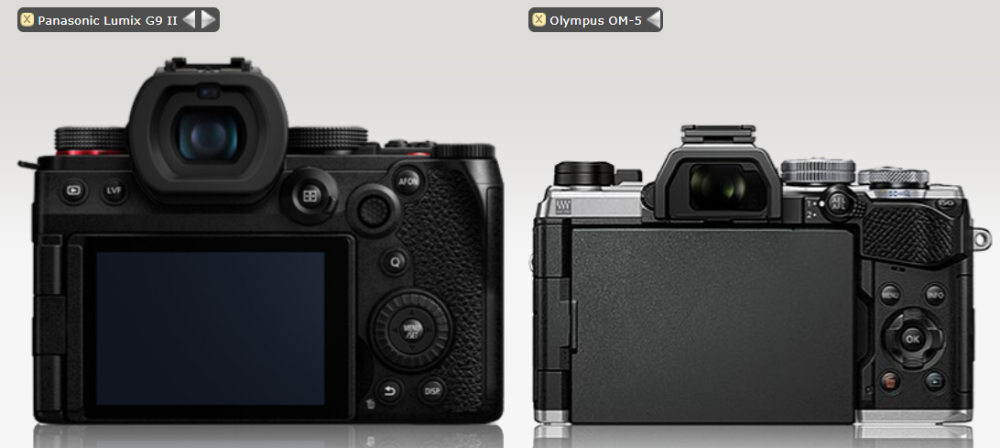Leaderboard
Popular Content
Showing content with the highest reputation on 06/18/2025 in Posts
-

Interested in the OM5ii for video? Get the E-M5iii instead.
John Matthews reacted to MrSMW for a topic
Or, instead of forcing my 6k open gate camera into shooting 4k cropped, I can stick with my smaller and lighter Sigma 28-70 f2.8 🤔 Arguably, the new zoom is the equivalent of 1mm wider and 10mm longer in terms of focal range and arguably f1.8 is still f1.8 for light gathering purposes, but for DOF equivalencies, f2.7 = f2.8, but nah, zero real world gains for my needs and a HUGE downgrade from 6k open gate. Now if the lens was significantly smaller and lighter, maybe a small argument could be made, but nah… For APSC users, it’s a different matter and the lens makes sense. Just not for me.1 point -
Interested in the OM5ii for video? Get the E-M5iii instead.
John Matthews reacted to ac6000cw for a topic
The G9 ii is much larger and over 50% heavier than an OM-5: The obvious M43 alternative (larger and heavier, but not as bad as the G9 ii) is a used OM-1 - almost a steal at it's current sub-£1000 used prices in the UK for what you get in a rugged, weather-sealed, reasonably compact body. And of course as MrSMW said, there's the S9 at sub-£1000 new, but that's not weather-sealed nor has an EVF. It's the lack of a compact M43 body with PDAF, 4k50/4k60 and excellent video IBIS that drove me to buy an S9 - my first ever non-M43 MILC (after 13 years of buying M43 cameras and owning a sizeable lens M43 collection). That said, the E-M5iii/OM-5/OM-5ii series aren't really aimed at the video-user market - they are primarily lightweight, small, weather-sealed stills-orientated cameras with a bit of retro style (which is an OM-System self-confessed niche, really).1 point -
Think about selling it and see how you feel. If you don't have a negative reaction to the thought, and it's not a practical choice, then sell it. If you do have a negative reaction to the thought of selling it, then think about how much you might get for it and what you could do with that money. Then think about swapping the camera for those other things and see which gives more excitement. Ultimately, if you're not shooting for money, then you're doing it for enjoyment, so ignore the specs and go with what would bring you the most happiness. Thanks! Not sure if I said this above, but my approach for the GX85 shots was to just apply enough of the film simulation in the FLC to get rid of the "video" look in the files, which I think was only about a third. The GX85 has a strong look to begin with, so I didn't need to add much to the colours. After many years working out colour grading tools and techniques across lots of cameras I've worked out how to get images to not look so digital, but now I can do whatever I want with them, I have to now work out what I want! It's a work in progress as everything is. Prores V-Log on the GH7 is an absolute joy. I have been doing some low-light testing over the last week or so in anticipation of my next balloon adventure, and I compared using a 17mm lens with using my new 9mm lens to get a 17mm FOV (firstly by shooting C4K Prores 422 and cropping to 17mm FOV in post, and also by shooting 1080p Prores HQ and cropping to 17mm in-camera) and even then, at ISOs of 5000 or more, the results were still not like the normal results from cheap cameras. In the grade it feels like footage from any cinema camera I've tried - the controls all feel great and the image responds how you want it to without colour shifts etc. Hell, I'm in groups where there are guys dealing with FPN from their RED cameras at base ISO that is worse than this camera has at ISO3200. Absolutely! There is something magical about this combo. I don't know what, but it's a joy to use and the files just seem to have something special to them. Dual GX85 bodies is a great way to go actually, and saves time in changing lenses all the time. Great stuff!!1 point
-
I did a bunch of testing some time ago comparing them, and they were less different than I thought they would be, and the CineD and Natural seemed to have the same latitude. I'm not sure if somewhere along the line I got confused between Natural and Standard though, so that might be something to test. Years on, the conclusion I've come to about colour profiles is that if you're going to colour grade in post with any kind of sophistication (and now with the Film Look Creator tool and Resolve colour management we have incredibly sophisticated tools) then it probably doesn't matter which profile you use. If I was limited to basic tools then I might just use CineD and be done with it. It's just preference really. The vND I'm using is the "K&F Concept 58mm True Color Variable ND2-32 (1-5 Stops) ND Lens Filter". They offer one with a larger range, but it isn't the True Colour one so I suspect it has more colour shifts. I've been really happy with it and my tests didn't show any colour shifts. I asked some professional cinematographers for advice and they said this was the cheapest one they'd recommend, so I suspect this is entry level. The NiSi ones were also recommended, but they're significantly more expensive. As always, do your own research, but if you're curious I might have my tests somewhere.1 point
-
From what you've said I would strongly suggest you to use Manual mode and to customise the dials individually (like @ac6000cw posted above) to configure one dial to be ISO ("Sensitivity" in the manual) and Aperture on the other. This would give you immediate control over the ISO (which you should only raise once the lens is wide open and there isn't enough exposure) and Aperture. This gives the advantage of the exposure of the shot not changing automatically during the shot. This is almost always something you want to avoid. Like I explained earlier - you don't want the exposure going up and down when bright objects come in and out of frame in the background. In situations where you do want the exposure to be adjusted during the shot, for example if you're moving from a light location to a dark one, or if lights get turned on/off, you can adjust these things with the dials. This will result in the exposure suddenly changing during the shot, rather than it gradually transitioning (as auto-ISO will do) but this is actually an advantage in post instead of a disadvantage. This is because if you need to adjust exposure during a shot then in post you can just chop the clip up into a few pieces (on the exact frames that the exposure changed when you changed the dials) and can automate the it from there. The challenge you have when using auto-ISO is that every shot where the exposure is drifting up and down will need to be adjusted with curves to compensate for what the camera did, and this can take literally hours. I shot a rodeo once using auto-ISO and a guy fell and the bull went over him, nearly treading on him, and so my framing went: him on top of the bull, pan down to him on the ground under the bull, him on the ground after the bull has run off. The exposure was all over the place as the elements in the frame changed and the camera "helped" me with exposure. The exposure automations I had to use to create an exposure that looked like nothing happened were complicated and took me literally hours. Had I shot it using one exposure then I could have just used a single exposure automation to bring up the exposure would have only taken minutes, and even if I'd have adjusted aperture or ISO during the shot it would only have added a few minutes in post to chop it up and adjust each segment individually. As you saw from my stress tests above, there is a lot of latitude in the files, so I cannot imagine that many situations where you'd want to change exposure during the shot. I used to be a full-auto shooter, and shot like that for years, listening to people online about how doing things manually was better. Now we have better tools in post, I have now fully switched to manual shooting as I've been through the pain of adjusting things in post to compensate for the camera wandering around. Just looked. I have -5 Contrast, -5 Sharpness and -5 NR, and 0 Saturation. There is a whole topic about why I have set these the way I have, but that's what I recommend. 5600K makes things look like what they actually look like. I shot for years using auto-WB and just couldn't make things look natural in post, they always looked like something was off in some way. This solves that issue. I found that when shooting in available light, even doing a custom WB on a grey-card gives a worse result than just using 5600K. I'd encourage you to set it to 5600K and carry the camera around with you in a pocket for a day with the smallest lens you can find and just take a 1s clip of every location you can find. Then pull them all into your NLE and see how they look. You might be surprised at how well it works across all the different situations. If you can, take it to some night markets where vendors are selling food from vans and people are selling low-value items. You will find the most incredible variety of ultra-low-quality lighting imaginable, as every vendor will buy the cheapest LED lights they could find at the time. Trying to "correct" for these lights will be futile, but the footage should still be a representation of the environment you shot in, even if it won't look like a beauty commercial. A note on testing... I shoot in similar situations to those you have mentioned, and I have come to the conclusions I have come to via lots of experience and an incredible amount of testing. Testing is so important to getting good results because so often you are convinced of something and then do a test to verify your opinions and find that the results are radically different than what you were expecting. So many people online are full of opinions that are so easily proven to be false with only a few minutes of real-life testing. I'm not sure if you've come across any cinematographers doing latitude testing of a cinema camera, but it's very telling that cinematographers (whenever possible) will do camera and lens and lighting tests prior to shooting a TV series or movie, and it seems like no-one doing videography or photography does these or talks about them. Hell, I was looking at a lens the other day and couldn't even find anyone who published test images at different apertures to see how the lens performed wide open vs stopped down. I found lots of photography bloggers who published lots of images and had lots to say, but testing? Nah.... Professionals test, amateurs guess.1 point
-
Have an 11 Ultra since it came out and it does provide wonderful image quality in MotionCam and McPro24Fps. Three things makes photography a difficult task on it though; For street photography I need an app that opens fast and captures fast (preferably the native camera app) 1. When you select 5x in the camera app it crops into the main sensor instead of switching to the native zoom sensor. You have to zoom to 10x and then to 5x again to fix it, every time. 2. The audio clips even at low levels and concerts can't be recorded at all for example. 3. The processing is bad on the native app and has a lot of smoothing and way too much contrast. So raw is really the only option. None of these was fixed for it. Considering the 15 Ultra and it does seem much better in most respects, but I'm not sure I trust Xiaomi after all this. GCam looks great on it though, if it´s fast enough. Anybody has any input on how 14/15 Ultra is to use in practice? The images in this thread does look great.1 point
-

Xiaomi 14 Ultra camera and RAW video mode
Juank reacted to Andrew Reid for a topic
Yes I have the Beastgrip DOF adapter, but... controversial opinion alert... Mirrorless cameras are a far better tool for interchangeable lenses. They have the grip, the physical controls, the EVF and the ergonomics and weight balance, where a smartphone just feels shit when there's a big weight on the front. For me, the Beastgrip was interesting to play with for a few shots, but nothing more. I just didn't see the point when I could just pick up an X-Pro3 instead. As a standalone camera the 14 Ultra has an upper-hand over mirrorless camera creatively though which is why I bought it... in that it's capable of firing off so many different shot styles on the spot, in a few seconds, with ease and speed... which I absolutely love and to do the same with interchangeable lenses would take forever and the shots would be gone or the light would be different. Not to mention the stealth factor for street photography too. I think the beauty of these smartphones is they are..... smartphones. Always with you, and no need to reach into a bag of lenses every time you see a shot worth taking.1 point


